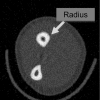The association of disproportionate skeletal growth and abnormal radius dimension ratio with curve severity in adolescent idiopathic scoliosis
- PMID: 20047062
- PMCID: PMC2899964
- DOI: 10.1007/s00586-009-1247-7
The association of disproportionate skeletal growth and abnormal radius dimension ratio with curve severity in adolescent idiopathic scoliosis
Abstract
Abnormal anthropometric measurements during the peripubertal growth spurt have been documented in adolescent idiopathic scoliosis (AIS). Magnetic resonance (MR) imaging studies of the spine have suggested a disproportionate endochondral and membranous ossification in AIS. The present study aimed at investigating whether disproportional ossification and skeletal growth occurred in the peripheral bone of AIS patients using the radius as the target bone. Skeletally mature AIS girls with different severity (n = 290) and age-matched control healthy girls (n = 80) were recruited. The anthropometric parameters were recorded. The midshaft of non-dominant radius was scanned with peripheral quantitative computed tomography (pQCT) and the radius diameter was calculated from the cross-sectional area. Radius dimension ratio was derived from the ratio of radius diameter to radius length. The anthropometric parameters were compared between AIS and control with adjustment for age. The radius dimension ratio was further correlated with curve severity in AIS girls using Pearson's correlation test. The analysis showed that the arm span and radius length were slightly longer in AIS girls. The BMI of AIS girls was significantly lower than the controls. The radius dimension ratio in severe AIS girls was significantly lower than the controls and the ratio of AIS girls correlated with the curve severity (r = -0.120; p = 0.039). The abnormal radius dimension ratio supported the presence of systemic growth abnormalities in AIS. Disproportional endochondral-membranous ossification could explain for the observation. The observation of the association of radius dimension ratio with curve severity provides an important potentially clinically measurable parameter for further longitudinal studies on the prognostication of curve progression in AIS.
Figures
Similar articles
-
Abnormal skeletal growth patterns in adolescent idiopathic scoliosis--a longitudinal study until skeletal maturity.Spine (Phila Pa 1976). 2012 Aug 15;37(18):E1148-54. doi: 10.1097/BRS.0b013e31825c036d. Spine (Phila Pa 1976). 2012. PMID: 22565390
-
Curve Progression in Adolescent Idiopathic Scoliosis Does Not Match Skeletal Growth.Clin Orthop Relat Res. 2018 Feb;476(2):429-436. doi: 10.1007/s11999.0000000000000027. Clin Orthop Relat Res. 2018. PMID: 29389797 Free PMC article.
-
Association of osteopenia with curve severity in adolescent idiopathic scoliosis: a study of 919 girls.Osteoporos Int. 2005 Dec;16(12):1924-32. doi: 10.1007/s00198-005-1964-7. Epub 2005 Sep 15. Osteoporos Int. 2005. PMID: 16163440
-
Etiologic theories of idiopathic scoliosis: autonomic nervous system and the leptin-sympathetic nervous system concept for the pathogenesis of adolescent idiopathic scoliosis.Stud Health Technol Inform. 2008;140:197-207. Stud Health Technol Inform. 2008. PMID: 18810025 Review.
-
Utilization of distal radius and ulna classification scheme in predicting growth peak and curve progression in idiopathic scoliosis girls undergoing bracing treatment.Eur Spine J. 2020 Apr;29(4):770-778. doi: 10.1007/s00586-020-06289-8. Epub 2020 Jan 16. Eur Spine J. 2020. PMID: 31950352 Review.
Cited by
-
Pathogenesis and biomechanics of adolescent idiopathic scoliosis (AIS).J Child Orthop. 2013 Feb;7(1):17-24. doi: 10.1007/s11832-012-0460-9. Epub 2013 Jan 13. J Child Orthop. 2013. PMID: 24432054 Free PMC article. Review.
-
Prognostic Value of Bone Mineral Density on Curve Progression: A Longitudinal Cohort Study of 513 Girls with Adolescent Idiopathic Scoliosis.Sci Rep. 2016 Dec 19;6:39220. doi: 10.1038/srep39220. Sci Rep. 2016. PMID: 27991528 Free PMC article.
-
Spot14/Spot14R expression may be involved in MSC adipogenic differentiation in patients with adolescent idiopathic scoliosis.Mol Med Rep. 2016 Jun;13(6):4636-42. doi: 10.3892/mmr.2016.5109. Epub 2016 Apr 12. Mol Med Rep. 2016. PMID: 27082501 Free PMC article.
-
Do adolescents with different types and degrees of idiopathic scoliosis curves differ in postural control compared to their healthy peers? a cross-sectional study.BMC Musculoskelet Disord. 2024 Dec 26;25(1):1071. doi: 10.1186/s12891-024-08210-6. BMC Musculoskelet Disord. 2024. PMID: 39725957 Free PMC article.
-
Genetics and pathogenesis of idiopathic scoliosis.Scoliosis Spinal Disord. 2016 Nov 28;11:45. doi: 10.1186/s13013-016-0105-8. eCollection 2016. Scoliosis Spinal Disord. 2016. PMID: 27933320 Free PMC article. Review.
References
-
- Kane WJ. Scoliosis prevalence: a call for a statement of terms. Clin Orthop Relat Res. 1977;126:43–46. - PubMed
-
- Lonstein JE, Lonstein JE, Moe JH. Idiopathic scoliosis Moe’s textbook of scoliosis and other spinal deformities. Philadelphia: W. B. Saunders; 1995. pp. 219–256.
-
- Weinstein SL. Adolescent idiopathic scoliosis: prevalence and natural history. Instr Course Lect. 1989;38:115–128. - PubMed
-
- Lowe TG, Edgar M, Margulies JY, Miller NH, Raso VJ, Reinker KA, Rivard CH. Etiology of idiopathic scoliosis: current trends in research. J Bone Joint Surg. 2000;82-A(8):1157–1168. - PubMed
Publication types
MeSH terms
LinkOut - more resources
Full Text Sources
Medical



